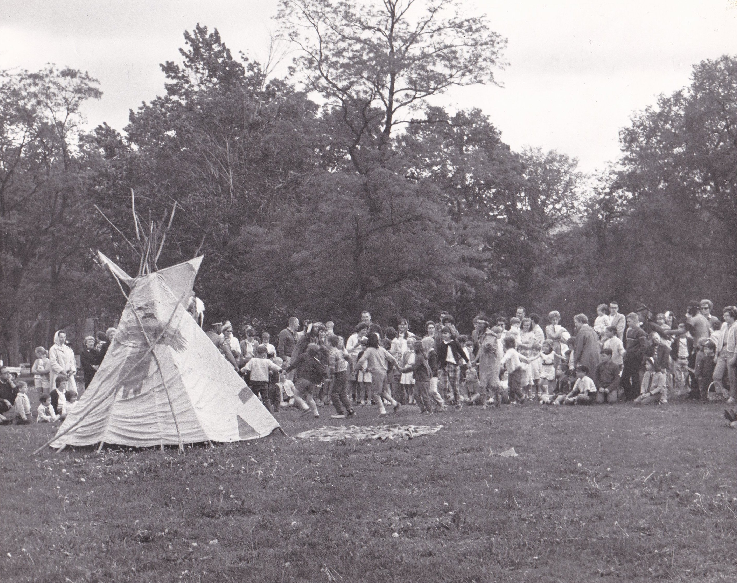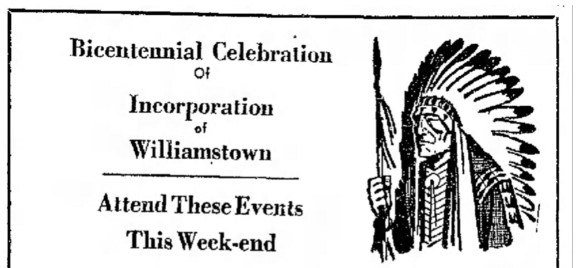
By Kendall McGowan
This article was published in our Winter 2021 newsletter. Read more of the newsletter here.
As an intern getting my first experience in cataloging with the WHM this winter, I was hoping to encounter surprises in the archives. Almost immediately, I struck upon a small mystery. It came in the form of photos of Williamstown’s bicentennial, celebrated by residents in 1965, to commemorate the town’s incorporation, which included acquiring its current name. The bicentennial planning committee arranged a number of activities, including parades, shows, and historical reenactments. Several of the pictures I found showed people in Native American-style dress participating in the celebration, dancing, performing rituals, and constructing tepees. This puzzled me, as the event whose anniversary was being commemorated– the official naming and establishment of a white settlement— took place in 1765, in the context of a widespread colonial effort to push Indigenous peoples off their lands, including the Mohican and Munsee people in what is now known as Western Massachusetts.
My curiosity led me to carry out some research and I found that, as an apparent effort to connect to the historical presence of Indigenous peoples in the area, white students from Springfield College’s Hosaga Club were hired by the planning committee to put on this performance. According to committee records, the group was paid $150 and their food and lodging were provided by residents. I did not find any evidence that the members of the club or the bicentennial committee made any effort to reach out to or learn the history or even the name of the Mohican people, who inhabited this region at the time of the town’s settlement.
If members of the Hosaga Club or the bicentennial committee had tried to contact Mohican community members, they might have discovered a more nuanced version of Williamstown’s history. As I looked into the bicentennial and began to research Mohican history, I started to compare the portrayal of Native Americans at the bicentennial to the reality of the Mohican Community’s experience over the past two centuries. By 1765, Europeans had already been in this region for a century and a half, according to Tribal Member Edwin Martin on the official Mohican website. In the 17th and 18th centuries, the resource- and culturally-rich Mohican society had been challenged and diminished by previously irrelevant factors like diseases, privatization of land, competition for resources, and white efforts to replace the existing culture and language with their own. Like other Native groups in the area, the Mohicans went on to support the colonists against the British in the Revolutionary War. In the first half of the 19th century, however, white greed for land pushed the Mohican community from one of their remaining villages in Massachusetts– Wnahktukuk, renamed Stockbridge– to land donated by the Oneida near Syracuse, NY, then to land in Wisconsin. There they were joined by a group of Munsee people and became known as the Stockbridge-Munsee.
The land in Wisconsin was covered by pine forest, with soil too swampy for farming. This, combined with broken promises by the government to provide adequate services in the area, led to conditions of poverty for many living there. To survive, many Stockbridge-Munsee people were forced to sell valuable cultural artifacts, the rights to lumber on their land, and the land itself. Through the early 20th century and the Great Depression, these challenges were only compounded. By 1965, policy changes and community effort meant the Stockbridge-Munsee could regain some of their land and reorganize their tribal government. However, the centuries of displacement, governmental mistreatment, and resource loss that occurred between 1765 and 1965 had imparted compounding and negative consequences for the Stockbridge-Munsee. With this perspective, it is clear that there was a disconnect between the bicentennial performances and the true Indigenous history of the area which they sought to represent.

The white members of Springfield College’s Hosaga Club were not alone in acting out Native American stereotypes, a practice today known as “redface.” Throughout the 20th century, the practice was ubiquitous in movies, sports, Halloween costumes, and even children’s games. While many depictions were deliberately disparaging, others, like the Hosaga Club, professed to be well-intentioned. A pamphlet produced by the club states that the group was founded in 1947 in order to “study the history, ritual, art, dress and dance of native American Indians,” with the ultimate goal of “realization of the wealth to be found in [their] cultures.” While this sounds like a well-meaning goal, portrayals of Indigenous people as exotic or foreign have long been used to justify historical and ongoing violence against them by the government. Other common misconceptions include the belief that Indigenous communities no longer have a significant presence at all, or are otherwise incapable of representing themselves, or that the diverse cultures of the 574 federally recognized tribes in the US are easily studied or interchangeable. These falsehoods can lead to cultural erasure or a denial of necessary resources or attention. When a role depicting an Indigenous person is given to a white performer instead of one from that background, they are denied not only the job but control over how Indigenous communities are presented to the world.
The WHM is committed to presenting an honest story of the region, and that story emerges over time. We are working to be thoughtful about how the history of the Stockbridge-Munsee Community is depicted at the Williamstown Historical Museum. In collaboration with the Stockbridge-Munsee Community’s Historic Preservation Office in town, we are revising our section on local Indigenous history and including more of this history throughout the museum. Every trip into our archives is capable of exciting curiosity and bringing up lessons like this one, which is why ongoing preservation and use of the WHM collection is so important!